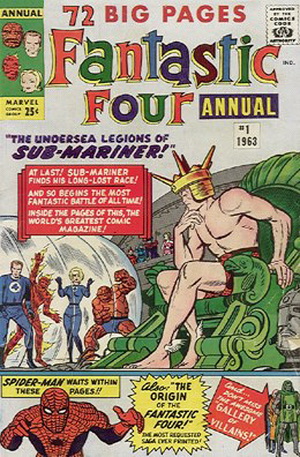
Published: 1963
Script: Stan Lee
Pencils: Jack Kirby
Inks: Dick Ayers
Letters: Art Simek
Now here’s something new—it’s called an “Annual” and it runs 72 pages, rather than a comic book’s standard 36 pages. For all this comic book splendor, readers of the day were asked to shell out more than twice as much money: a full 25 cents! Were they getting their money’s worth? Let’s review the contents of this first Fantastic Four Annual, then you decide for yourself.
NAMOR
On the cover we find reference to four different features, as well as clear pictures of Sub-Marinar, Spider-Man and Doctor Doom. Well, you’ve got my attention. This looks to be grand, and as we turn the first page, we find that it is. After the full page splash for “Sub-Mariner Versus the Human Race!” we are invited to King Namor’s coronation ceremony regally presented on a two page spread showing us all the splendor of Atlantis.
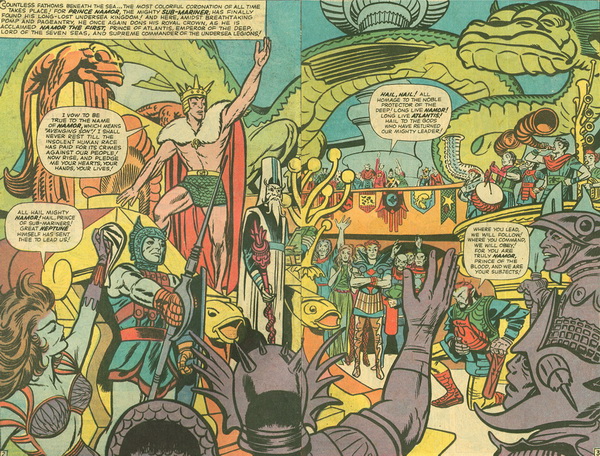
Yes, we know, the sea serpent doesn’t line up. The printing process in 1963 required a gutter between the two pages, and a case could be made that the serpent WOULD line up, if we retained the gutter. The down side, though, is that other elements would then be out of kilter. We simply had to make the aesthetic decision: do we retain the gutter, or close it up? We think it looks better as one huge panorama, the first of its kind for Marvel. –Russ
Last time we saw Namor, he was still looking for his people. Now he’s found them, and they welcome him back with open arms. I don’t remember ever before seeing a two page spread, but given the occasion, it’s entirely appropriate.
I know Namor is supposed to be a bad guy, but I can’t help feeling happy for him. He’s finally found the thing he’s been looking for all this time, and feels restored to his proper place in the universe. Maybe now he can be content and stop picking on the surface dwellers?
Not a chance. The ceremony isn’t even over, and already he’s planning his attack upon the human race. He captures the FF, only to send them back with an important message: as King of the Sea, 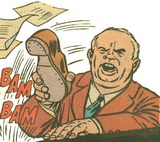 he will allow no ships or aircraft to trespass his domain. Reed convenes the United Nations and conveys the gravity of the situation, but the delegate from Russia responds with a hearty “Bah! Capitalistic lies!” and a bit of shoe-pounding on the table.
he will allow no ships or aircraft to trespass his domain. Reed convenes the United Nations and conveys the gravity of the situation, but the delegate from Russia responds with a hearty “Bah! Capitalistic lies!” and a bit of shoe-pounding on the table.
After they get this guy calmed down, Atlantean expert “Dr. G. W. Falton” provides a detailed history of the fabled kingdom and its “homo mermanus” race. (No, you haven’t forgotten them from 8th grade biology class. Like that troublesome “chromosomatic gland,” this is another science fact fiction found only in Marvel comics.)
Dr. G. W. Falton paints a very pretty picture of the the history of Atlantis, and of Sub-Mariner’s background in particular, only…there is no Dr. G. W. Falton! We have been listening to an expert, however, for Falton rips off his disguise, and guess what? It’s Sub-Mariner himself, startling everyone, and declaring war on the human race before hurrying back to his undersea kingdom.
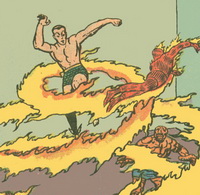 Soon, the Atlanteans invade, wearing water-filled helmets to keep them alive until victory is won. Reed gets one look at a helmet and immediately deduces a solution. He fashions a huge “complex electronic device.” Sadly, this contraption is not given a proper name, like “Electromagnetic Evaporator Ray Gun,” but no matter—it gets the job done, evaporating the water from every soldier’s helmet, forcing a mass retreat back to the ocean.
Soon, the Atlanteans invade, wearing water-filled helmets to keep them alive until victory is won. Reed gets one look at a helmet and immediately deduces a solution. He fashions a huge “complex electronic device.” Sadly, this contraption is not given a proper name, like “Electromagnetic Evaporator Ray Gun,” but no matter—it gets the job done, evaporating the water from every soldier’s helmet, forcing a mass retreat back to the ocean.
Sub-Mariner quickly decides that ONLY Mr. Fantastic could be responsible, and hurries to the Baxter Building. Fighting ensues, and Namor escapes with Sue as hostage.
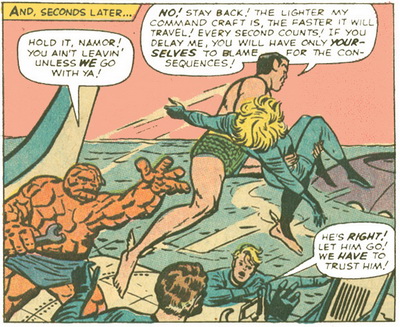 With much fanfare, the others rescue Sue, who is nearly drowned. They must trust Namor to deliver her to the nearest hospital. Namor’s people feel that he has betrayed them by saving a surface woman, so they abandon him. Poor Namor! From the highest high, to the lowest low, he ends this lengthy tale wondering, “Is there NEVER to be a place for me?”
With much fanfare, the others rescue Sue, who is nearly drowned. They must trust Namor to deliver her to the nearest hospital. Namor’s people feel that he has betrayed them by saving a surface woman, so they abandon him. Poor Namor! From the highest high, to the lowest low, he ends this lengthy tale wondering, “Is there NEVER to be a place for me?”
Not to worry, I’m sure there will always be a place for Namor, the Sub-Mariner, King of the Sea, in the pages of Marvel Comics. These stories are just too good! And I haven’t even gotten to the best parts yet! One of the most fun aspects of these Sub-Mariner stories is the romantic triangle between Reed, Sue and Namor. Each time these three appear together, there’s further development, further angst. And this time, we are introduced to two new players, creating yet another romantic triangle.
Enter Lady Dorma, an Atlantean babe with blue skin and high cheekbones who considers Namor her true love. As the story begins, she is delighted that Namor has returned, envisioning a future where she is queen, ruling the undersea realm side by side with her king. The moment I saw Lady Dorma, I knew there would be trouble. As expected, she is not at all pleased when she figures out that her man is in love with another woman. And not only another woman, but a surface-dweller! Brrr…
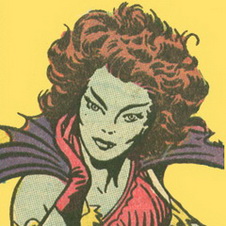
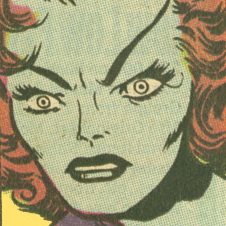 Dorma begins the story as the gentle and beautiful woman you see here on the left, but by the time she learns about Namor’s attraction to Sue Storm, she looks like this:
Dorma begins the story as the gentle and beautiful woman you see here on the left, but by the time she learns about Namor’s attraction to Sue Storm, she looks like this:
To complicate matters further, Warlord Krang is interested in Lady Dorma, and apparently they’re engaged—at least if “pledged to become the bride” means the same thing in Atlantis as it does on the surface world. But Dorma wastes no time throwing over her Warlord for the newly returned king…and 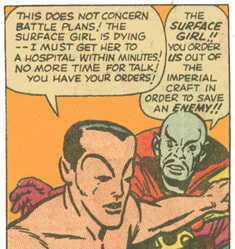 can you blame her? Emotions aside, Krang is rather hideous. His heart must be in the right place, though—the place Namor’s heart should be, completely intent upon the safety and well-being of the kingdom, not half given over to the protection of a…a…SURFACE GIRL!!
can you blame her? Emotions aside, Krang is rather hideous. His heart must be in the right place, though—the place Namor’s heart should be, completely intent upon the safety and well-being of the kingdom, not half given over to the protection of a…a…SURFACE GIRL!!
This title has opened up a whole new world, full of interesting characters. Frankly, I was disappointed when I got to the end and found out the entire civilization had deserted their King. I certainly hope this is not the last we see of Warlord Krang and Lady Dorma. They have some unfinished business with Namor, and—don’t spoil me, but, it would be a shame if the momentum of this new love triangle is not picked up at some time in the future.
HORSEPLAY
So I look forward to that, but right now, I’ve got some bones to pick with our “surface dweller” heroes. We start with a good dose of FF-Nonsense, as we usually do, with some horseplay between Johnny and Ben that gets out of hand—fire, water, busting down doors, you know the routine.
Sigh. I’ve got to say…I’m really getting tired of this. Okay, Johnny’s a teenager, so some horseplay might be expected, but what the hell is Ben thinking? Or is he thinking? When those cosmic rays altered his physique, was he also touched in the head? Or has he always been this infantile? The two of them act like they’re ten years old, and there’s no excuse for that.
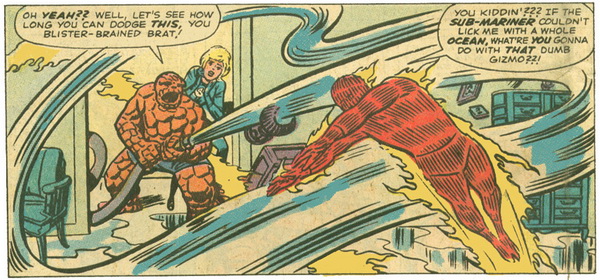
In the end, their horseplay ruins all of Sue’s expensive, “original exclusive” dresses. Ben/Thing at least apologizes, but his explanation that “It was an accident,” just doesn’t cut it. Why doesn’t he take responsibility for his bad behavior? Why doesn’t Johnny? And why does Reed feel he has to comfort the crying Sue with “I’ll make it up to you, honey”? There’s no reason Reed should have to make up anything—he didn’t do anything wrong!
But, wait! Yes, he did. As the leader of this group, he should have put his foot down a long time ago, rather than allowing these two imbeciles to continue to misbehave. He’s got this giant scientific brain, yet he doesn’t seem to understand the first thing about human interaction.
And then! To make matters worse, Reed does what no parent should ever do: he actually REWARDS the bad behavior with, “I think we’ve been working too hard! We need a VACATION!”
What??? Did I hear right? Johnny and Ben destroy Sue’s property, and as a result, everyone gets to go on a VACATION? At this rate, Johnny and Ben will never stop acting like jackasses. Pardon my language, I’m really mad about this.
But wait! There’s more! To make this whole ridiculous situation even worse, just before Reed suggests the vacation, Sue actually APOLOGIZES to the “boys” for getting so emotional. Again I say…WHAT?? Why in blazes is Sue apologizing? “Oh, I’m sorry, boys, for being such a FEMALE. Can you ever forgive me?” She didn’t do anything except have a perfectly legitimate reaction, and yet she feels compelled to apologize. At best, this is an outrageously chauvinistic portrayal of women in the 1960’s. At worst, Sue’s got some major self-esteem issues.
TYPE A PERSONALITY
But let’s get back to Reed and his proposed vacation. In the last issue, didn’t he and Sue just go on vacation to Hawaii? Of course, that wasn’t a real vacation, it was just an opportunity to test drive the Intercontinental Ballistic Missile Station Wagon.
And this isn’t a real vacation, either. Sea monsters have been spotted in the middle of the Atlantic, and Mr. Fantastic wants to investigate. Leave it to a science nerd like Reed Richards to think that taking a cruise to find sea monsters is a “vacation.” Does this guy never relax? Can you say…Type A personality?
Later in the story, when Namor catapults the four from the depths to the middle of the Atlantic Ocean, and drowning seems a real possibility, Reed takes time to explain the science that got them there. To which Thing replies, “What an egg-head! Reed, if they ever strapped ya in the electric chair, you’d probably be explainin’ how the blamed thing works while they pulled the switch!”
’Nuff said.
Of course, the others continue to display their defining personality characteristics as well. For instance:
When Reed is injured and must give detailed instructions on the Electromagnetic Evaporator Ray Gun, Sue exclaims, “Let’s just PRAY that it works!” once again indicating her lack of faith in Reed’s ability to get the job done. I’m starting to think Reed should be looking for a girlfriend who’s a little more supportive.
When Ben’s blind girlfriend invites herself on the “Vacation to Sea Monsters,” Ben keeps making references to sight—“You’re a sight for sore eyes…wouldn’t let you out of my sight…” Really, Ben…could you BE any more insensitive?

And Johnny, of course, is still chasing girls. I’m just not sure why he’s referring to himself in the third person here, and especially baffled why he would call himself “Little Johnny.” Hmmm…let’s not go there…
NAMOR
But enough of this! Let’s get back to Sub-Mariner, because the more I write, the more I’m liking him better than the heroes in this tale.
WE’RE NOT AS DIFFERENT AS YOU MIGHT THINK…PART 1:
As Dr. G. W. Falton, Namor reveals his origins. In 1920, a blast from a ship rocks Atlantis, and Princess Fen surfaces and falls in love with the ship’s captain. As a result of this union, Namor is born, “possibly the first known mutant of our time…the only true human amphibian on earth.”
Now this brings up a question: Is Namor a mutant, or a hybrid? Apparently he has characteristics of both his father and mother; he can breathe air, he can breathe water. His skin appears to be human flesh (not blue), yet he has wings on his feet that allow him to fly. He’s the perfect blending of the two races, like a Ford Fusion, that can run on either gas or electricity.
Incidentally, I was baffled by the fact that when the water is drained from the Atlanteans’ helmets they must immediately retreat to the ocean, as if they will die within moments. In the story about Sub-Mariner’s parents, wasn’t his mother able to breathe air for up to five hours? Why are the current Atlanteans not as hearty and capable? Perhaps some…mutation?
BUT WAIT! THERE’S MORE!
Well, I’ve given more than enough attention to this main story, but that’s not the only attraction in this Annual. When you buy a DVD, you get the feature film, and also a bunch of “extras,” and “behind the scenes” documentaries. Briefly, here are a few “DVD extras” from this first Annual:
The Fabulous Fantastic Four Meet Spider-Man! This six-page vignette re-tells a portion of a story that appeared in Amazing Spider-Man #1. It’s pretty much the same as before, but some of the fight scenes have been expanded. I guess some people like that kind of thing, but for me, I gloss over that part with “And then they fight,” or “Fighting ensues,” so this tale didn’t do anything for me.
However, I did find it amusing that on the title page, the editor informs us that this story is appearing “By special arrangement with Spider-Man magazine.” Uhh…correct me if I’m wrong, but it’s all Marvel Comics, right? So, where’s the “special arrangement”? Stan and Jack looked at each other said, “Hey! Let’s rehash that old story, and add in a few more details, ya think?” And it was done.
Questions and Answers About the Fantastic Four. Now, this was an entertaining bit that offered all kinds of details about our heroes. Most of it we already know, but the write-up on Sue really floored me. I had no idea her hobbies included cooking and reading romantic novels! (I also had no idea that “cosmetics” was a hobby.)
Most alarming of all is the question “If she marries, would she leave the F.F.?” Really now…why should she? I guess back in the day, once a woman got married, she left the work force. But I hardly think what Sue does as a super-heroine can be considered a “job” in the usual sense of the word. How would being married affect her ability to participate in the foursome?

Yes, we know, the picture’s not straight. Back in the 60’s, sometimes the publishers weren’t as careful as they should have been to cut the corners of every panel at 90° angles. No matter which way we cut it, at least two sides are going to slant.
–Russ
But then…ahh! It suddenly occurs to me. Of course, as soon as Sue gets married, she would be expected to start popping out babies. After all, that’s a woman’s “real” job, isn’t it? But it does beg the question…if Sue and Reed were to have children, what would they be like? And what kind of trouble could those youngsters get into, turning invisible and slipping into all the hard-to-reach places? Nothing would be safe! I don’t know, maybe Sue and Reed do eventually get married and have children. If you know, don’t tell me! I want to be surprised when it happens.
A Gallery of the Fantastic Four’s Most Famous Foes! Eleven foes grace this gallery, each given a full page write-up. I don’t know if the purpose is to entice new readers into tracking down and reading past issues, or were they just trying to fill space. Either way, looking at these characters makes me realize how far I’ve come. I have no idea how much further I have to go, but I’m sure this retrospective is just the tip of the iceberg.
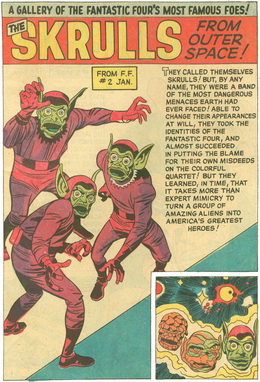 If you’ve been reading along with me all this time, you know that I pretty much consider the Skrulls a huge joke. So I found it extra funny when their gallery page describes them as “a band of the most dangerous menaces earth had ever faced.”
If you’ve been reading along with me all this time, you know that I pretty much consider the Skrulls a huge joke. So I found it extra funny when their gallery page describes them as “a band of the most dangerous menaces earth had ever faced.”
We’re told that the Miracle Man (remember him?) “seemed stronger than the Thing, more brilliant than Mister Fantastic, more powerful than the Human Torch, and more elusive than the Invisible Girl!” At least here, we temper the praise with the word “seemed.” The Incredible Hulk also makes an appearance in this gallery, though by the time this Annual hits the newsstands, Hulk has already made his giant about-face, aligning himself with the newly-created Avengers.
One more feature: a full-page diagram of Inside the Baxter Bldg, detailing all the rooms, labs and inventions which go into making the Fantastic Four 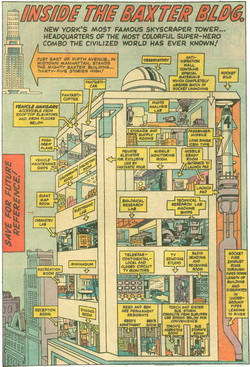 so…well, fantastic. I love maps and diagrams, and this one is no exception. Marvel provided similar diagrams in issues 3 and 6, but that was quite a while ago, and now that readers know the FF better, perhaps this is a good time for review. And just to be sure further review will not be needed, a bold suggestion is made to “Save for future reference!”
so…well, fantastic. I love maps and diagrams, and this one is no exception. Marvel provided similar diagrams in issues 3 and 6, but that was quite a while ago, and now that readers know the FF better, perhaps this is a good time for review. And just to be sure further review will not be needed, a bold suggestion is made to “Save for future reference!”
Little girls had their Barbie dolls and dreamhouses, but what about little boys? They’ve got this detailed diagram of Fantastic Four headquarters. Marvel-themed toys and playsets won’t come along for at least another thirty years, so until that happens, this two-dimensional representation and a good dose of imagination will have to suffice.
![]() And coming up soon, a good dose of imagination when Marvel marks the spot in comic history with an exciting new title. So join me next time for more fun in the Marvelous Zone!
And coming up soon, a good dose of imagination when Marvel marks the spot in comic history with an exciting new title. So join me next time for more fun in the Marvelous Zone!
| Want to read this comic on your computer? Marvel has a scan! Want to own this story? Buy the Masterworks! |















Actually, while Marvel didn’t have it’s own toy division until the ’90s, they licensed their heroes to Mego in starting in the early ’70s: http://www.megomuseum.com/wgsh/. (But no, no Baxter Building playset.)
What a Marvelous website you reference! Though it looks like Mego had cornered the market on both Marvel and DC toys and trinkets — a collector’s dream! I’ll have to search further and see if they’ve got any bobbleheads. I’m a big fan of bobbleheads.
There was an Amsco brand Marvel playset contemporary to the Mego toys. There was a Daily Bugle building, Dr. Strange’s Greenwich Village home (with the distinctive Ditko circular window) and a Baxter Building. They were all assembled from thick laminated cardboard into three dimensions but sat about an inch from one another in a shallow tray (actually the box the set came in). Worse, the super-heroes were printed on the same cardboard in two dimensions and stood up with the help of plastic wedges. The Mego toys blew them away, really. Kids would make their own headquarters out of pillows, boxes, whatever. Although a Fantasticar or Pogo Plane would have been cool.
You’re making me wish my brothers had had an interest in Marvel comics and toys back when we were kids, because I would love to be able to see these things! I took a quick look on E-bay but couldn’t find them, so I imagine they’re pretty rare.
You made me laugh with your reference to the cardboard two-dimensional super-heroes! But I guess the great thing about being a kid is that if you can use your imagination to create “headquarters” from pillows and boxes, you could also bring those cardboard figures to life in your mind as well.
I recently reconnected with some of the toys from my own childhood and have developed a real interest in 1960’s nostalgia, so thanks for this look backwards!
Growing up I loved Marvel’s Annuals; the extra-long stories and special features were a treat and they were designed to appear in the summer months, when kids were out of school. This is one of the best Annuals, with plenty of story and drama.
Your point about Ben and Johnny acting like children is certainly true. Ben is supposed to be an adult, but often acts like Johnny’s older brother. I think Stan and Jack liked the interplay, as did the fans, so don’t expect it to go away anytime soon.
Your observation about Reed and Sue rewarding the “kids” is on the money. I never thought about it, but they both have a lot to learn. Any yes, Sue’s apology is really stupid, even from a 1960’s mentality.
Sub-Mariner using a disguise? Maybe I was correct when I concluded that Namor WAS the Fox is Strange Tales Annual # 2!
We start with a good dose of FF-Nonsense, as we usually do, with some horseplay between Johnny and Ben that gets out of hand—fire, water, busting down doors, you know the routine.
Sigh. I’ve got to say…I’m really getting tired of this.
Thank you! I’m glad it’s not just me.
Even as a youngster, when I read those tales ‘way back in the olden days, the humour in the Ben/Johnny squabbles grew thin very quickly for me.
I understand where Stan Lee was coming from. He emphasised characterisation in his heroes, to make them distinctive from DC’s costumed stars, who all seemed to be cut out of the “stalwart, ace good-guy” mould. I didn’t have a problem with either approach (well, I was always annoyed by Peter Parker’s constant whining), but if you’re going to script your heroes on the basis of heavy characterisation, then it still has to be logical characterisation.
As you pointed out, Johnny Storm was a teen-ager, so his immaturity was to be expected; heck, it’s a teen-ager’s stock-in-trade. But Ben Grimm has no such excuse. Yes, he may talk like a dock worker, but let’s look at his curriculum vitae.
He held a college degree (yes, he got in on a football scholarship, but it still took brains to get his sheepskin) and that was a bigger deal in the early ’60’s than it is, now. He was a Marine fighter pilot during World War II—and being a Marine, even an aviation Marine, requires discipline. Moreover, the experience of war matures a man very quickly; nothing makes one grow up faster than a bunch of people doing their damndest to kill you.
Lastly, before his ill-fated trip into space, he was a test pilot—a job which takes brains and attention to detail and self-discipline.
With those credentials, Grimm would logically be next member of the Fantastic Four to assume a leadership rôle, after Reed, and not acting like one of the students from Blackboard Jungle. Ill-tempered, yes; running off at the mouth, to be sure. But it didn’t make sense to depict him as an overgrown kid, and I couldn’t buy into it.
To make this whole ridiculous situation even worse, just before Reed suggests the vacation, Sue actually APOLOGIZES to the “boys” for getting so emotional. Again I say…WHAT?? Why in blazes is Sue apologizing? “Oh, I’m sorry, boys, for being such a FEMALE. Can you ever forgive me?” She didn’t do anything except have a perfectly legitimate reaction, and yet she feels compelled to apologize.
This is the kind of observation that makes your perspective as a female fan interesting. When I read this dialogue in the comic, I didn’t attach any thought to it, except as it moved the story along. It was obviously meant to add more emotional drama to a scene that was already, to my mind, ridiculous. But it didn’t have any lasting impact, such as making me view Sue as weak or wimpy. I just read it and moved on to the next page.
But, naturally, to another woman, Sue apologising for a perfectly legitimate reaction would be a big, red flag. The thing is it’s not that Stan Lee, or any other male writer, wrote dialogue like that with the intention of subordinating females as over-emotional creatures. It’s just that a male wouldn’t get it.
Case in point: I am reminded of an occasion, several years ago, when the Good Mrs. Benson and I were watching an early-’60’s rerun of the old quiz show Password, hosted by Allen Ludden. For those of you who came in late, the show consisted of two celebrities paired off with two “civilian” contestants. One team of celebrity/ordinary person was pitted against the other. And there was always one male and one female celebrity, and one male and one female contestant.
In this particular episode we were watching, it was the introductory part of the show, where Ludden was getting acquainted with the contestants, and the exchange went something like this:
“Miss Big-Time Celebrity, you’ll be playing with Mr. Joe Hogbristle of Palmdale, California. What do you do for a living, Joe?”
And Joe Hogbristle of Palmdale, California, chatted a bit with Allen about his occupation and his wife and family.
Then Ludden turned to the other side of the table and said:
“And Mr. Famous Star, your partner will be Mrs. Joan Spatula from Benkelman, Nebraska. What does your husband do for a living, Joan?”
I didn’t give that question a second thought, but I could feel the Good Mrs. Benson stiffen next to me on the davenport, and when I looked, I saw her roll her eyes.
What had gotten to her, of course, was Ludden’s (no doubt unintended) implication that a married woman like Mrs. Joan Spatula of Benkelman, Nebraska, wouldn’t have an occupation of her own—other than housewife and baby-maker.
But it’s just the sort of thing that a guy wouldn’t notice.
Love that Password story! It’s so indicative of the 1960’s.
As for Ben Grimm, my only explanation is that the cosmic rays must have altered his brain or his hormones or something like that, to make him act like such a doofus.
>Okay, Johnny’s a teenager, so some horseplay might be expected, but what the hell is Ben thinking? Or is he thinking?
As far as I can see this is a unique and important issue from the regard of Johnny and Ben’s horseplay. This is the climax, and leads to a change. The horseplay is a whole subplot on its own, and every issue is different when we look closely.
IMO there are distinct phases to Ben’s emotional progression:
Phase 1: anger. In issues 1-3 Ben was mad as hell at what happened to him: how he had everything (looks, brains, muscle, sexy job as a test pilot, and a good chance of winning Sue away from Mr Test Tube), then Reed took it all away from him. His looks were gone, and next to Reed’s achievements his own university degrees counted for nothing. All he had was a pile of muscle, like some ugly thug, no wonder he was angry!
Phase 2: try harder. Then he got over it and we move to stage two where he tries to make the best of it. In issues 4 and 5 we can see a competition between the three men to be the most amazing: a lot of showing off. Ben carrying the bomb on his back, Johnny creating a whirlwind, and at the end of issue 5 we can see the wasteful way they each try to show off, how to perform a simple job like leaving the castle.
Phase 3: Reed pulls ahead: Then from issues 6 to 12 Reed’s scientific know-how leaves the others in the dust. Out in space (issues 6 and 7) he’s in his element, and in 11 and 12 he makes the most of his official role as leader, which before this was more a “first among equal” thing. True, issue 9 starts with a major setback to Reed’s ego, but it all ends with being movie stars, and who’s going to look best then? The handsome guy or the monster?
Phase 4: Reed’s triumph. Issues 13 and 14 are when Reed finally reaches the moon and returns in glory. For all this time Ben has Ben increasingly frustrated, Reed treats him like a little child, and there is nothing he can do about it. Ben is no psychologist, He is way over his head. He’s angry, frustrated, confused, can’t see any future except to stay in the team and be treated like a little child.
Which brings us to annual 1. Annual 1 immediately follows issue 14. As you rightly point out, this is Ben at his worst, having a tantrum. Except I would call it a nervous breakdown. Johnny doesn’t have the emotional maturity to see what’s happening. He’s just a kid who’s been raised by his sister so he has no idea how an adult man is supposed to behave: he sees Ben is easily upset, so he pushes all Ben’s buttons and has a laugh.
But Ben IS an adult. he knows he has gone too far. In annual 1 he reaches a climax of childishness and knows he cannot live like that. So from the next issue (issue 15) he stops fighting:
Stage 5: resignation through dark humor. Starting with issue 15 we have Ben’s famous self deprecating humor. He starts to wisecrack. He knows he’s lost, he knows he’s treated like a child, so he plays up to it. We start the feud with the Yancy Street Gang. Ben is no fool, he could just ignore them and they’d lose interest, but he plays up to it. Issues 15-18 are the saddest. A lot of the time Ben literally sits huddled in the corner.
After that he settles down to the new status quo.
Step 6: the new status quo. From issue 19 Ben is no longer childish. He acts as a wisecracking adult. So he is no longer such an irresistible temptation to Johnny, who is himself growing older. After a few more issues the horseplay gradually subsides. On the surface everybody is happy, but from time to time we catch a glimpse of Ben’s inner world, and it’s not a happy one.
Post-1990 spoilers:
Incidentally, this is one of many reasons why I believe the Johnny Storm from the 1990s and beyond is a completely different character. The kidding around ended in the early 1960s. But returns in the 1990s, an especially in Mark Waid’s run (2002-4 IIRC). Why? Because by the 1990s any new writer on the book did not have time to read all the previous issues, so would base their idea of the team on the first 20 issues or so, without seeing the long term character development. That’s how I see it, anyway.
So back to annual 1. Something I love about these stories is how no detail is wasted. If Ben is at his most immature here there is a reason, and this leads to a change in direction in the next issue. it all evolves organically, naturally, realistically. And another thing I love is how this works on different levels. Sure, we can see it as comic relief. but as Shakespeare teaches us, the fool is often the deepest and most tragic character.
tl;dr the Johnny and Ben subplot has its own development, and this issue is the climax.
You know, I never really considered all the emotions Ben/Thing must be going through as a result of his transformation. I mean, I considered it briefly, but never in such detail, and all of this makes absolute sense. Sort of like the five stages of grief, he runs the gamut. I guess I have to give him a little leeway.
Thanks for throwing some fresh light on all this!